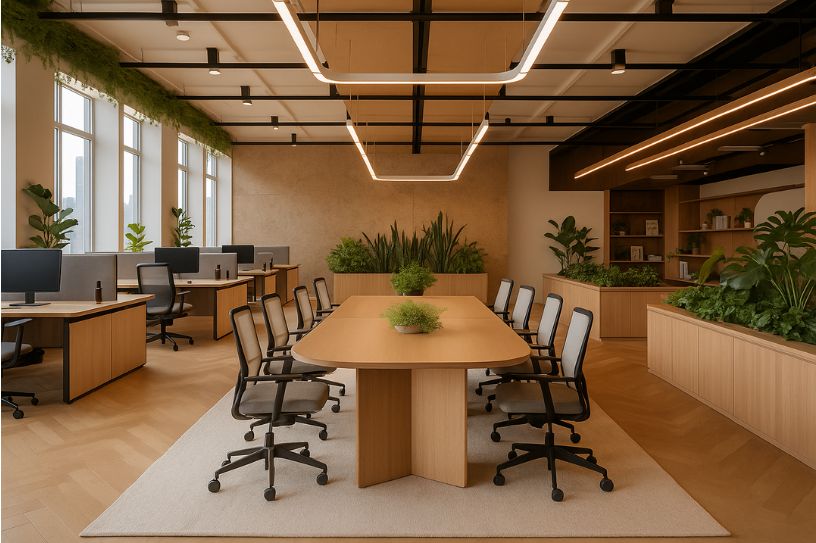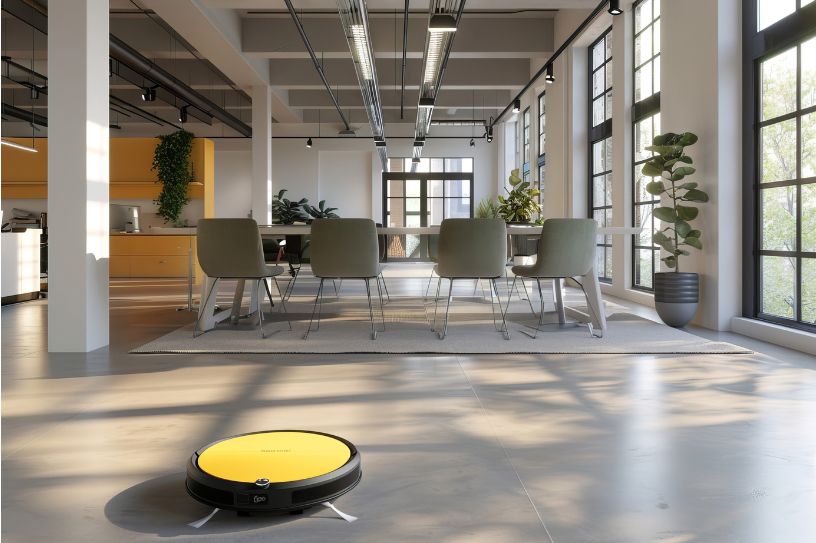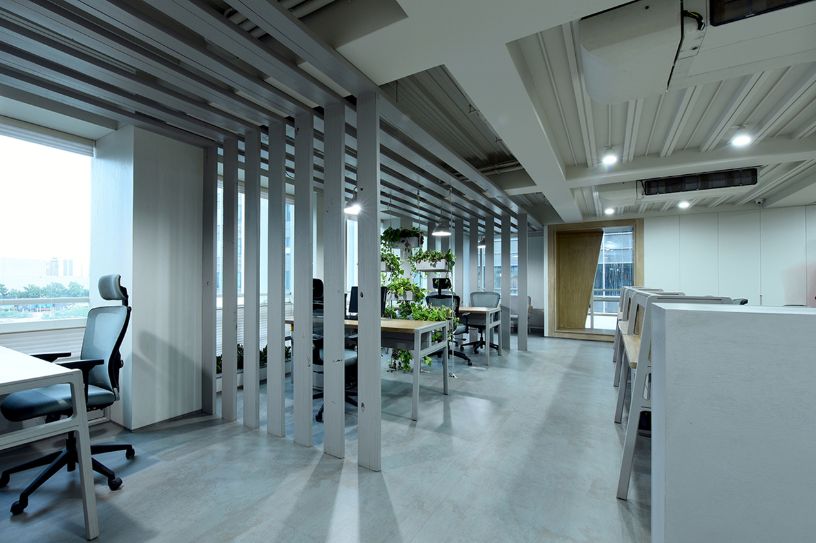
Burnout and stress at work are becoming prevalent issues in today's workplaces. Employees frequently experience physical and mental exhaustion due to long hours, strict deadlines, and ongoing pressure.
Office design is more important in this situation than most people realise. Mood, energy and productivity are all directly impacted by the appearance and atmosphere of a workplace.
Stress can be decreased and a healthier work environment can be created with the help of natural light, soothing colours, open areas and even furniture arrangement.
In this blog, we will talk about how good office design can lower stress, stop burnout and make the workplace healthier. You’ll also find some easy design tips that can truly help.
Key Elements of Wellbeing-Focused Design
There is more to a healthy workplace than just computers and workstations. People's daily emotions are greatly impacted by the way their workplace is designed. Employees can become more focused and relaxed with minor interior design adjustments. Below are a few essential components of wellbeing-focused design.
1. Natural light & views of greenery
Sunlight has a significant impact on energy and mood. Employees feel more engaged and less fatigued in offices with lots of windows or open areas that let in natural light. Having a view of greenery, whether it is trees outside or a small garden inside, can calm the mind and make the workplace feel refreshing.
2. Biophilic elements
The office is made to feel more alive and fresh by adding natural materials, wooden textures or plants. These components provide comfort, lower stress levels and improve focus.
3.Quiet Spaces and Acoustics
One of the main sources of stress at work may be noise. One way to reduce noise is to design areas with quiet rooms, soundproof walls or soft textures. This establishes quiet areas where workers can concentrate better.
Ergonomics and Comfort

There is more to being comfortable at work than just having a table and chair. Long hours spent sitting incorrectly can cause back pain, fatigue and even stress in workers. Ergonomics, or designing for body comfort, is therefore important in any workplace.
- Chairs and desks with adjustments:
Each employee is different in height and body type. With adjustable desks and chairs, they can sit or stand in the way that feels most comfortable for them. They feel less stressed and more at ease all day long as a result.
-
Supportive lounge seating for breaks:
Break time ought to feel like just that—a break. Before returning to work, employees can unwind and rejuvenate on cosy couches or lounge chairs.
-
Easy-to-access movement zones:
It's bad for your health to sit still all day. Employees can take short breaks for movement in offices with open walkways, standing areas or walking-friendly spaces.
Must read : Create Affordable Eco-Friendly Office Design
Calming Materials & Colours
Although they may seem like minor details, office colours and materials have a significant impact on employees' moods. An atmosphere that is calm and stress-reducing can be achieved with the correct colours and textures. A thoughtful colour scheme and cosy furnishings create a more inviting work environment.
- Muted and gentle hues:
Restlessness can occasionally be brought on by harsh, bright colours. A calming effect is produced on the mind by soft colours such as beige, green and light blue. People feel more at ease when they are reminded of the outdoors by colours inspired by nature.
- Colour Schemes Inspired by Nature:
Even when indoors, colours that mimic trees, water or the sky can help staff members feel more connected to the natural world. These hues infuse the workplace with harmony and optimism.
- Materials that feel warm:
The room feels cosy and welcoming when soft surfaces, fabric and wood are used. Soft and touch-friendly materials make the office feel warmer and less cold or machine-like. This helps employees feel more relaxed and comfortable.
Offering Retreat & Recharge Spaces

Workplaces can become hectic and noisy, which frequently leaves workers exhausted or preoccupied. Having designated spaces where people can retreat is important. Because these areas allow the body and mind to relax, workers come back to work with greater vigour and focus.
- Meditation rooms, quiet areas and nap pods:
Employees can take a break from the continuous activity and noise in quiet areas. Small rest areas or nap pods allow them to unwind for a brief period of time, and meditation rooms offer a calm environment for stress relief and mental clarity.
- Comfort Corners:
Breaks don't have to be long. Comfort corners with soft lighting, cosy chairs, and calm décor provide a quick escape. Before going back to work, staff members can take a seat, take a breath or just relax.
Spaces for relaxation and recharging are more than just a luxury. They help workers in preventing burnout, enhancing concentration and feeling valued at work. Because of this, the workplace is encouraging and productive.
Read more : Office Design Elements to Enhance Hygiene
Case Example / Client Highlight
One client highlight is how we help them enhance employee well-being through the use of thoughtful office design. Many employees complained of feeling exhausted and stressed out during long workdays before the redesign.
The project's objective was to design a room that felt more supportive, serene and natural. Large windows were installed to let in natural light, and indoor plants were positioned in various locations.
The office had a cosy welcoming vibe because of the use of soft colours and wood textures. To encourage employees to take short breaks, quiet areas and cozy lounge nooks were also added.
Surveys after the changes revealed that workers felt more comfortable and concentrated. Many people mentioned how much they loved lounging in the lounge areas and even how they would use the meditation areas on hectic days.
Practical Recommendations
Redesigning an office entirely is not always necessary to enhance employee well-being. The workplace can be significantly improved with even minor fast adjustments. Businesses can create a more serene and encouraging environment by adding basic elements like:-
- Indoor plants:
Adding tiny plants to desks or nooks gives the office a vibrant new look. They also aid in calming people down and lowering stress.
- Soft partitions:
While maintaining an open and welcoming work environment light dividers or screens can provide employees with privacy and reduce noise.
- Adaptable lighting:
Natural sunlight and lights that can be turned up or down make the office more aesthetically pleasing and comfortable to work in.
- Aromatherapy diffusers:
These emit mild fragrances like lemon or lavender which promote relaxation and reduce fatigue in workers.
- Green walls:
In addition to adding beauty to a space plant-covered walls purify the air improving worker health.
Conclusion
Designing an office is about more than just how it looks; it's also about how it makes people feel. A well-planned environment can reduce stress, avoid burnout and enhance productivity.
Every component of design, from ergonomic furniture and peaceful nooks to natural light and greenery, contributes to a happier and healthier work environment. Workers are more attentive, creative and efficient when they feel valued and comfortable.
At Serein Spaces, we think that wellbeing should always be a part of design. Our initiatives show how well-designed interiors can boost staff morale and productivity.
We can help you if you want to make your office a place that improves performance and lowers stress. The time has come to develop spaces that genuinely help people, not just offices that serve a purpose.
Check out our wellbeing-focused design services and start creating a workplace where employees can feel relaxed, recharge, and do their best work

